
Welcome to a special edition of
Breaking Ground. We’re going to depart from the normal routine of off-the-wall deckbuilding this week to take a look at some specific cards for the upcoming Silver Age tournament season. In honor of Pro Circuit San Francisco and the official start of Silver Age, I have compiled a list of twenty-five cards—three from each booster set and one from the starter decks—that I believe will have a profound impact on the Silver Age metagame.
In the immortal words of Jerry Reed, “We’ve got a long way to go, and a short time to get there.” So let’s start this hootenanny!
Web of Spider-Man
1)
Flamethrower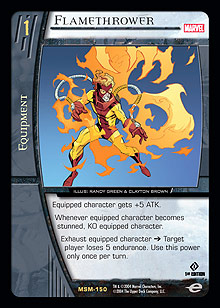
We start out hot with one of the strongest equipment cards in Vs. System to date.
Flamethrower not only gives its bearer a whopping +5 ATK, but it’s also good for a direct 5 endurance loss to your opponent. The 1 threshold cost of the equipment is well worth the price, as it allows most characters to swing one to two spots up the curve. Just be careful who you equip
Flamethrower to, because once that character becomes stunned, both the character and the
Flamethrower will depart your board for the KO’d pile. Of course, if you’re playing an off-curve deck and you’ve reached your kill turn, then that extra +5 ATK or 5 endurance loss may be just what you need to close out the game. Since the game will be over that turn anyway, it probably won’t matter if one of your characters gets KO’d.
2)
Unmasked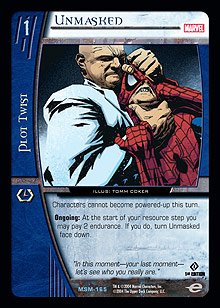
While Big Brotherhood and the age of
Lost City abuse may be gone for the moment, there are still several teams that make a tradeoff powering-up their characters. The JLA, JLI, and JSA teams all have very potent effects that trigger off the ally ability. Since ally abilities trigger when any one of your characters becomes powered-up, the potential for mayhem certainly exists when there are multiple ally characters in play. You may recall some of the scenarios possible with multiple ally abilities from
my article on
Roll Call!. In my testing, it was not uncommon for me to have
Connor Hawke ◊ Green Arrow,
Shayera Thal ◊ Hawkwoman,
Katar Hol ◊ Hawkman, and
Firestorm in play simultaneously . . . and all equipped with
Nth Metal! That basically meant that on each attack, I had the potential to gain +4 ATK / +1 DEF, search my deck, and draw another card in the bargain. Fortunately,
Unmasked can shut down all of this madness. If characters can’t become powered-up, then ally effects cannot trigger. Hence, no more mayhem.
3)
Latverian Embassy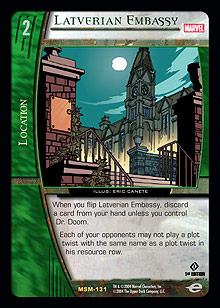
Dr. Doom may have taken a powder from the Silver Age, but his presence can still be felt at his home away from home, the
Latverian Embassy. Several decks in Silver Age will probably rely on having multiple copies of certain plot twists in play (
Faces of Evil, anyone?). If you can get a copy of
Latverian Embassy in play early, then you can effectively lock out future copies of certain plot twists. Moreover, in decks with additional sources of plot twist disruption (such as Injustice Gang), you can use
Latverian Embassy to create effects similar to having
Dr. Doom, Diabolic Genius in play. Probably the best card for this is
The Joker, Headline Stealer. As long as you can keep your opponent’s hand count up (not a difficult task in an Injustice Gang deck), he or she will be forced to play plot twists out of the resource row. Once those plot twists are flipped up, you can keep them gone for good with
Latverian Embassy. The prospect of limiting G’Lock to one copy of
Helping Hand per game makes me absolutely giddy!
4)
Roy Harper ◊ Speedy, Mercurial Marksman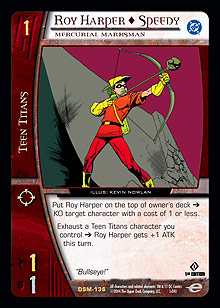
Though not the force that he was during Golden Age or the last DC Modern Age, Speedy is still a force to be reckoned with. With the prospect of several off-curve decks in Silver Age (most notably
Anti-Green Lantern rush), Speedy can be a great equalizer. For the cost of a resource point, the Mercurial Marksman will KO an opposing 1-drop—no muss, no fuss. If you happen to be playing a deck that has alternate methods of getting 1-drops into play (such as
Changeling or
Dr. Light, Master of Holograms), then you can bring Speedy out for free. Though Teen Titans may not be prominent in Silver Age, the smallest of the Roy Harpers would surely represent the adolescent fighting force with honor . . . and a lot of tiny arrows.
5)
Men of Steel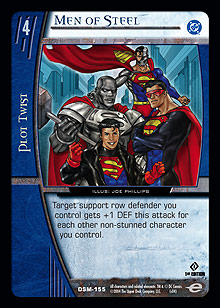
Speaking of arrows, the slings and arrows of outrageous fortune managed to rid the game of arguably the most powerful defensive plot twist in Silver Age—
Cover Fire. For players who favor aggressive decks, this is welcome news. But for those who favor more defensive, stall-oriented decks, this is a devastating blow. While Silver Age has its share of defensive tricks, none of them are on par with
Cover Fire. In order to stay competitive, the late-game decks will need to look at other defensive tricks to survive. This is where
Men of Steel comes in. While not as good as
Cover Fire or perhaps even
Helping Hand,
Men of Steel does have potential in its own right. Several of the
Qward and Blue Abuse decks from
Pro Circuit Indy last year used
Men of Steel to great effect. One of the very nice aspects of
Men of Steel is that it doesn’t place any conditions on the characters that provide the defensive boost (other than that they are non-stunned). Compare this to
Cover Fire (which requires characters with range) and
Helping Hand (which requires characters with willpower), and it’s obvious that
Men of Steel has a good deal more flexibility. Granted, it can only be played on a support row defender. But given the number of characters with range in Silver Age, as well as the numerous ways to give a character range, this won’t often be a problem.
6)
Phantom Zone 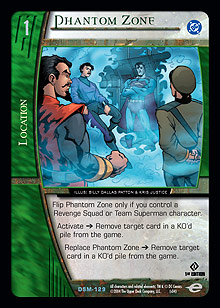
Now we come to one of my personal favorite cards in Vs. System. As I have said on more than one occasion, the strongest decks are generally those that can effectively utilize all zones of play. Curve Sentinels and Teen Titans are stellar examples of this. Both decks had elements that allowed for significant interactions with the board, hand, and deck. However, where they rose above other decks was with their ability to interact effectively with the KO’d pile. Having the cards in the KO’d pile at your disposal is invaluable, as it effectively provides another resource from which you can draw. This trend continues onward into Silver Age with cards like
Hard Sound Construct,
Felix Faust, and
Dr. Light, Master of Holograms. These cards are cornerstones of several decks in Silver Age because the decks that play them would be significantly weaker without them. Of course, we can’t eliminate these cards from the game, but we can nullify their effects.
Phantom Zone has a reusable effect that allows us to remove from play the target of any recursion card. With such vital recursion effects negated, many decks will simply fall flat. It remains to be seen, however, if anyone will be able to find a way to harness the awesome potential of
Phantom Zone, given its restriction of play with only the Revenge Squad or Team Superman—two teams not regarded highly in the current metagame.
Marvel Knights
In Golden Age, there was one surefire way to improve the consistency of a combo deck: add the Marvel Knights to the mix! With a myriad of combo enablers, like Wild Ride and Micro-Chip, the speed and consistency of these complex setups improved dramatically. Of course, the foundation for the deck was Midnight Sons. Having a card that allows teaming-up without even having one of the teams present is amazing! And Midnight Sons came packaged with its very own search card in the form of Dagger, Child of Light. Now, not only do you have a card that can team-up virtually anything, but you also have a way to get that card into your hot little hands. The potential for Midnight Sons engines has not diminished in Silver Age. There are still several combo deck possibilities available, notably the Secret Six Victorious deck that has many players buzzing. Although teaming-up won’t fulfill the win condition of Secret Six Victorious, the Secret Six team certainly could use the extra character search that Wild Ride provides.
The
Midnight Sons engine also supports multiple teams. Take a look at New School: I think there were about 215 different teams in the original version of that deck! Finally, you can use
Midnight Sons to provide support to teams that don’t have a lot of it in Silver Age. If you really want to,
Midnight Sons can let you build that Speed Force deck you’ve been aching to play. It’s just that good!
8)
Meltdown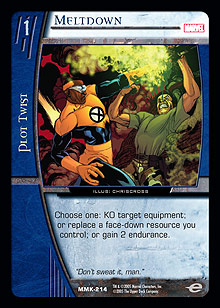
Here’s a hypothetical question: If I were to tell you that there’s a playable Silver Age card that acts as a defensive pump, removes reinforcement, and can remove team-ups, would you be willing to play it? Well, such a card does exist, my friends! Its name is
Meltdown.
Meltdown is equipment hate first and foremost, and given the abundance of equipment cards that we will probably see in Silver Age, that could be very substantial. Want to give your opponent -2 ATK across the board? Just use
Meltdown on his or her
Blackbird Blue. Need to swing in for some serious breakthrough? Have
Meltdown KO that copy of
Catcher’s Mitt. And what about that copy of
Image Inducer equipped to
Joystick? Not only will
Meltdown drop her ATK, but it will also remove that extra team affiliation. It is a beautiful card, and the surprise factor of playing it packs quite a punch. Of course, the great thing about
Meltdown is that it’s never a dead card, even against decks that don’t play equipment. For a little added deck cycling, use
Meltdown to replace a face-down resource. At the very least,
Meltdown can provide some marginal endurance gain. In a close game, a copy or two of
Meltdown can be the difference between victory and defeat.*
9)
Mikado and Mosha, Angels of Destruction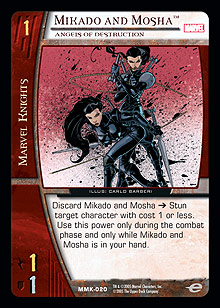
And now, my choice for “The Card that Every Player Should Play One Of”:
Mikado and Mosha. I am, and have long been, a big fan of this card. It is one of the best pieces of tech that any player has against off-curve decks, especially in Silver Age. Optimally, I would recommend that a deck play two or three copies of the Angels of Destruction. Of course, against decks like
Anti-Green Lantern rush, even a single copy can have far-reaching effects. How? Let’s hear it straight from the shortest of sages, Tim Batow:
“Using one copy of Mikado and Mosha against AGL will prevent 11 damage—2 from Chomin and 9 from the Xallarap that won’t be staying around for the next turn.”
For the price of a single discard, you can prevent 11 points of endurance loss, stun an opposing character, and get rid of a monstrous 3-drop. How great is that? Granted, the dividends reaped against other off-curve decks may not be nearly as great. Still, a timely
Mikado and Mosha on a character like
Joystick can turn a well-conceived attack into a massive catastrophe. And the paybacks increase on team attacks, as the other attackers will usually fail to stun your character. You’ll end up with a completely unscathed character on your board, while your opponent will have two of his or her best characters stunned. All that for a single little discard!
Green Lantern Corps
10)
Birthing Chamber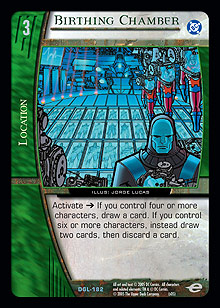 Birthing Chamber
Birthing Chamber is one of the best cards in Vs. System at converting deck strength in a specific area into a source of advantage in another area, one that is usually weak. What does this all mean? This should help clarify: A major strength of a standard
Faces of Evil deck is that it can put several low-cost characters into play, then inflate the size of those characters to make up for the disparity of not following the curve. This usually results in significant board advantage for the
Faces of Evil player. So, what is the deck’s major weakness? Because it generally plays off curve, it puts several cards into play each turn. As a result, the
Faces of Evil player’s hand size is usually pretty small. Now, put two and two together. What does
Birthing Chamber do? It allows a player to draw extra cards based on the amount of characters he or she has in play. In essence,
Birthing Chamber converts board advantage to hand advantage. Brilliant! In off-curve decks, this can be as simple as actually having character cards in hand to play on turns 5 and 6. In control and stall decks, this can increase the resources you have at your disposal with which to accomplish your strategy. As long as you can keep the requisite number of characters in play,
Birthing Chamber is a win-win proposition . . . unless you’re playing against the Injustice Gang, of course!
11)
Dr. Light, Master of Holograms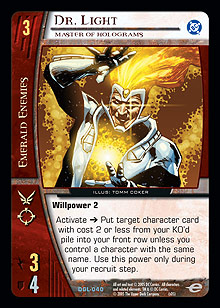
Our next guest needs no introduction. Love him or hate him, you cannot deny that Dr. Light is amazing. Not only has he revolutionized the game’s approach to off-curve strategy, but he’s also inspired two separate errata by UDE to prevent overly powerful deck types from flooding the metagame. Any card that possesses that kind of potential has to be good. So, why is Dr. Light so good? Well, think about it this way: Let’s say that UDE created an ongoing plot twist with a 3 threshold cost called Light Show. The text on the plot twist reads, “As an additional cost to play Light Show, pay 3 resource points. At the start of your recruit step, you may put a character card with cost 2 or less from your KO’d pile into play if you do not control a character with the same name.” Would you play that plot twist? I sure would! Paying 3 resource points to get free 2-drops for the remainder of the game is a great investment. Of course, that is what Dr. Light effectively does—he turns those 3 resource points into an endless recursion of 2-drops. With some of the amazing 2-drops in Silver Age and the multiple methods of getting them into the KO’d pile, Dr. Light can turn the most meager of boards into a mass of miniature men. All that for 3 measly resource points doesn’t quite seem fair, does it?
12)
No Man Escapes the Manhunters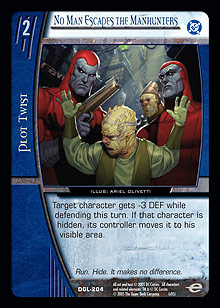
I have a particular mindset about ATK pumps. Unless the boost is absolutely immense (like
Savage Beatdown or
All Too Easy), pumps need to have additional beneficial effects to be worth playing.
No Man Escapes the Manhunters is the first of several pumps that fall into this category.** At the base minimum,
No Man Escapes the Manhunters saps an opposing defender of 3 DEF. That, by itself, is respectable. However, there are two other facets to this card that really push it over the top. First, the targeted defender gets -3 DEF while defending for the entire turn. Not only does this mean that
No Man Escapes the Manhunters can be played at any time during the turn (which can be exceedingly useful when up against cards like
Lex Luthor, Nefarious Philanthropist), but it also means that the targeted character will lose that DEF for each attack. If your opponent somehow manages to boost that character’s DEF high enough to avoid one attack,
No Man Escapes the Manhunters will still be active for a second and even third attack. Needless to say, that character will get stunned! Second,
No Man Escapes the Manhunters doubles as tech against hidden characters. That little
Chomin is indeed vicious, but he tends to lose a bit of his bite when you drag him out into the visible area for your characters to pound on. And let’s just see how long
Donald Pierce stays a 16 ATK / 16 DEF beast when you pull
Sage, Tessa out to sit right next to him. There are many opportunities to tech against hidden characters in Silver Age.
No Man Escapes the Manhunters should be right at the top of your list for dealing with those threats.
The Avengers
13)
Mutant of the Year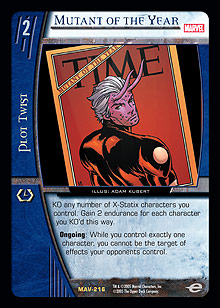
Admittedly, this card is pretty narrow in its usage. Even though any team could potentially benefit from its effect, X-Statix is probably the only team that has the support to pull it off effectively. But the reason that I decided to include this card is that it has the potential to shut down an entire set of archetypes in Silver Age. Some of you may recall that the winning deck at the last two Golden Age $10K events was a concoction known as High Voltage. This little monster may very well be the ultimate deck in terms of early game aggression with its slew of low-cost ATK pumps and burn cards that deal massive damage in the game’s opening turns. With a decent draw, turn 4 kills were not uncommon. However, the unlikely X-Statix sporting
Mutant of the Year became the ultimate foil to High Voltage. With
Mutant of the Year preventing almost all burn damage, High Voltage went from dealing massive doses of damage to doing next to nothing. Although High Voltage does lose some of its more potent weapons in Silver Age, there is still no shortage of strong burn cards;
Golden Archer and
Die for Darkseid! are sure to find places in prominent decks. It is entirely possible that the favored X-Statix deck of Keebler Powell and his buggy buddies could make an enormous splash at PC: San Francisco . . . sporting a healthy compliment of
Mutant of the Year, of course!
14)
System Failure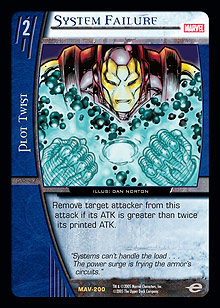
Currently, the only banned card in the Vs. System is
Overload, and with good reason.
Overload is an amazing card—so amazing that it became downright abusive. The capacity for creative deckbuilding became very restricted with the oppressive
Savage Beatdown /
Nasty Surprise /
Overload combo dominating the metagame. The subsequent replacement for
Overload,
System Failure, is not as dominant. However, to say that
System Failure is not a good card because it isn’t as strong as
Overload would be like saying one million dollars isn’t a lot of money because it isn’t as much as two million dollars.
System Failure wins games, folks! Just ask Aaron Weil—it led him to a perfect 10-0 record on Day 1 of PC: LA! With the very real possibility of an abundance of off-curve decks in Silver Age,
System Failure needs to be considered for any deck that wants to maintain its board. Granted, it won’t be useful in every matchup, but the prospect of negating a single attack could be the difference between victory and defeat. I don’t know about you, but I’ll take a million dollar payday anytime, even if it isn’t quite as good as two million.
15)
Null Time Zone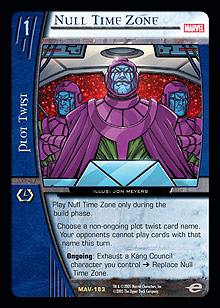
Speaking of
System Failure, what happens if you’re the player on the other side of the coin? If you are playing a deck with a lot of little characters that use various ATK pumps to get big, then a card like
System Failure is a very real concern to you. As I said, negating a single attack can be the difference between victory and defeat. So, to shut down those plot twists that can ruin your day, you should wield a few copies of
Null Time Zone. The possibilities for
Null Time Zone are quite plentiful in Silver Age. Of course, ATK and DEF pumps are obvious targets. In addition, recovery tricks like
Panacea Potion and
Lanterns in Love can be good calls to prevent unforeseen attack complications. Or maybe you’d like to keep your characters safe from KO effects like
Stolen Power and
Emerald Twilight. As you can see, there are several cards that
Null Time Zone can shut down for a single turn. If you plan to play a deck that is vulnerable to specific plot twists, then you might want to pack a few copies for insurance. And don’t forget that you don’t have to name the plot twist until the resolution of the effect, so make sure that your opponent makes all of his or her responses before you say what card he or she will be deprived of for the turn.
Justice League of America
16)
Die for Darkseid!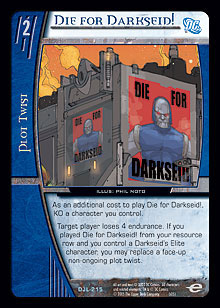
What does 4 direct endurance damage and makes
Gorilla Grodd cry? Why, it’s This unassuming card from the
Justice League of America set has found a home in the hearts and decks of many a Vs. System player. For the cost of a card and a character,
Die for Darkseid! will give you a slight edge in the endurance race. In a deck like
Anti-Green Lantern rush, where some of your characters will get KO’d at the end of the turn anyway, this becomes a more than fair trade. In fact,
Die for Darkseid! does not require that the character you KO be non-stunned. So, at the end of your turn, if you’re going to lose a character anyway, you might as well get a bit of payback against your opponent by burning him or her for 4 endurance. The secondary effect of
Die for Darkseid! probably will not come into play very often, as there likely won’t be many Darkseid’s Elite decks in Silver Age. Still,
Die for Darkseid! is a great burn card that can help aggressive decks chisel away their opponent’s endurance. And don’t forget that it also counters
Gorilla Grodd!
17)
Glass Jaw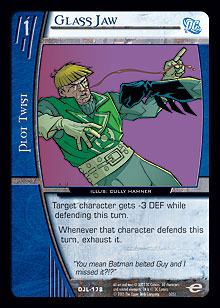
What could be better than a card that not only acts as an ATK pump but can also thwart potential return attacks?
Glass Jaw is very similar in effect to
No Man Escapes the Manhunters, giving -3 DEF to an opposing character while defending. Also like
No Man Escapes the Manhunters,
Glass Jaw can be played at any time during the turn and has a secondary beneficial effect—
Glass Jaw exhausts an opposing character when it becomes a defender. There are several implications of such an effect. Paired with a card like
Sucker Punch,
Glass Jaw ensures that your characters won’t get stunned back. There is also a potential combo with cards like
Crushing Blow that could allow your characters to attack way up the curve. Probably the most important effect, however, is that the defending character will not get a chance to attack that turn (barring a way to ready the defending character), even if your opponent manages to keep that character from stunning.
Glass Jaw is not outrageously good, but it is definitely a solid ATK pump that merits consideration for several decks in Silver Age.
18)
Slaughter Swamp
Our final card from the
Justice League of America set is sure to be splashed in many thematic decks across Silver Age. One big problem with all of the sets from the past three Modern Ages was that there were very limited options for recursion. Obviously,
Dr. Light, Master of Holograms ran rampant through DC Modern Age, and
Hard Sound Construct was a key card for the X-Faces decks that found so much success in the last Marvel Modern Age. But one major problem with these cards was that they were very restrictive in their use, limited to characters that cost 2 or less and often only functional for a specific deck archetype. In the upcoming Silver Age, however,
Slaughter Swamp will be available to all deck types. While it is not as functional from a board perspective as Dr. Light or
Hard Sound Construct (because it puts character cards back into your hand), it doesn’t have any restriction on the character’s cost or team. There will undoubtedly be several decks that sport the
Mikado and Mosha /
Slaughter Swamp control mechanism for keeping weenies in check. Just discard
Mikado and Mosha to stun a 1-drop and then fetch the card back with
Slaughter Swamp. Repeat as often as needed. In addition to putting cards back into your own hand,
Slaughter Swamp can work in a pinch to put character cards in your opponent’s hand. Against a deck like Squadron Supreme, this can be a big advantage. Just let your opponent’s attack with that massive 15 ATK / 11 DEF
Albert Gaines ◊ Nuke (with
Rocket Central in play) become legal. Then use
Slaughter Swamp to send
Shape back into your opponent’s hand. While giving your opponent cards may not normally be a sound strategy, this little tactic will result in a -5 ATK / -3 DEF stat reduction to Nuke. There isn’t a defensive pump in the game that can match that kind of action! There are many possibilities with
Slaughter Swamp, so it is certainly a card that deserves some consideration for your Silver Age deck.
The X-Men
19)
Mutant Massacre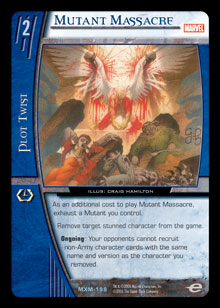
If you plan to play a Silver Age deck with Mutant characters from the X-Men set, then you must include this card. In a deck without Mutants,
Mutant Massacre is worthless, but it instantly goes from worthless to invaluable when you toss a few muties into the mix. Very few players disagree with the fact that cards that remove opposing characters from the board are among the most powerful in Vs. System.
Finishing Move has long been a staple of Teen Titans and Curve Sentinels decks worldwide.
Chopping Block was one of the most feared cards in DC Modern Age. And cards like
Quick Kill,
Stolen Power, and
Death Trap were almost always first-pick worthy in Draft.
Mutant Massacre is a board control card and much, much more! Not only does the character targeted by
Mutant Massacre get removed from play, but also character cards with that name and version cannot be recruited again. Granted, it is limited to non-Army characters, but it’s still an absolutely game-breaking effect! What happens to
Anti-Green Lantern rush when it can no longer recruit
Felix Faust? What about G’Lock when it’s deprived of Dr. Light? And does
Faces of Evil have any chance if you prevent
Beetle, Armorsmith or
Yellowjacket from being recruited again? It may be restricted to a pretty select group of teams, but
Mutant Massacre is well worth playing if you find yourself with Mutants to spare in your Silver Age deck.
20)
Image Inducer
Vs. System players are a greedy bunch. It doesn’t matter how good the cards were in previous sets; they want the cards from new sets to be bigger and better. Case in point:
Dual Sidearms was a Golden Age standard for Squadron Supreme rush decks. But when the X-Men set was released, players everywhere dropped the guns for copies of
Image Inducer. Okay . . . the rush to
Image Inducer was probably due to the upcoming Marvel Modern Age. Still,
Image Inducer was a very potent card in the Squadron deck. You thought
Joystick was big before? Just wait until she gets a boost from
Rocket Central and
Airskimmer!
Image Inducer’s ability to pump a character’s ATK and give characters extra team affiliations was a major reason that FTN found so much success with its Squadron deck at PC: Atlanta. Playing a deck full of different teams that you can unite under one banner without having to play Team-Ups is a beautiful thing. But the fun doesn’t have to end with Squadron Supreme decks. Imagine being able to play
Spider Senses on
Malvolio. How about using
Qwardian Council Hall to boost
Jubilee’s stats? It would even be possible to attack with Bart Allen ◊ Flash and then exhaust him for
Stolen Power to get a counter! Yes! It’s an attack boost and a Team-Up all in one card!
21)
Enemy of My Enemy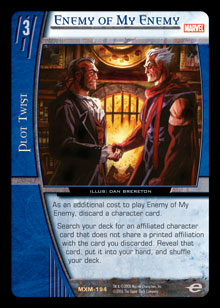
Yeah . . . if you weren’t expecting to see this card on my list, then you haven’t been reading my column on a regular basis. In my humble opinion,
Enemy of My Enemy is the most powerful card ever printed in Vs. System. Prior to the release of the X-Men set, character search was generally limited to teams that were lucky enough to have a search card. If you wanted to give search capability to a team that was otherwise deprived, you could Team-Up with another team that had character search. But if you couldn’t get the Team-Up online, then you were stuck. The Justice League of America set remedied this problem somewhat with
Straight to the Grave and
Secret Origins, but
Straight to the Grave required some sort of recursion to be playable, and
Secret Origins was heavily dependent on what characters your opponent played. Then,
Enemy of My Enemy exploded onto the scene and changed Vs. System as we know it. Suddenly, Team-Up decks were a great way to ensure that you hit your drops because you could put drops from different teams into your deck to ensure that you had targets for
Enemy of My Enemy. Given that some of the strongest synergies in Vs. System come from teaming-up various affiliations,
Enemy of My Enemy adds potential to promising decks that might not otherwise have seen play due to a lack of search capability. Whether it is improving established archetypes or enabling new, off-the-wall builds,
Enemy of My Enemy is sure to be a staple in competitive Vs. System deck in Silver Age and for many years to come.
Infinite Crisis
22)
Removed from Continuity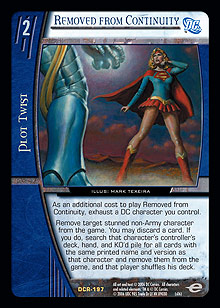
Remember
Mutant Massacre?
Removed from Continuity is every bit as good as the Mutants’ specialized board clearing card and isn’t nearly so restrictive. There will undoubtedly be several decks in Silver Age that sport primarily DC characters.
Anti-Green Lantern rush, Good Guys, and the infamous G’Lock are all good examples. If you happen to be playing one of these or another DC-flavored deck in the Silver Age and you decide that you need some assistance keeping your opponent’s board clear, this card is certainly worth taking a second look at. At the very least,
Removed from Continuity removes a stunned character from play. But the fun really begins with a simple discard. Then you can search your opponent’s hand, deck, and KO’d pile for all cards that share a name and version and remove all of them from the game. Again, just like
Mutant Massacre, these effects are limited to non-Army character cards, so don’t try to get abusive against
Soldiers of New Genesis. Still, the only thing better than preventing an opponent from recruiting a particular character is removing all copies of that character card from the game. Not even Dr. Light or
Hard Sound Construct can save you now, Beetle!
BWA HA HA HA HA!23)
Blinding Rage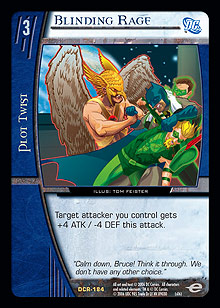
Remember how I said that ATK pumps need a secondary beneficial effect to be playable? Well, I lied.
Blinding Rage is an ATK pump that really has no beneficial secondary effect to speak of . . .
Or does it?
Consider the scenario presented in Mr. Tim “Aqualad” Batow’s discussion on Mikado and Mosha. Now that Chomin has been stunned, there’s no way for Xallarap to get stunned, so he’ll stick around next turn . . . unless we play Blinding Rage on him! Not only does the big 3-drop get even bigger, but he also loses a bit at the back end, making it entirely possible for several 3-drops to stun him. If we play multiple copies of Blinding Rage on Xallarap, then pretty much any sized character will be able to stun him. Okay, I realize that arguing the point of having a card that can allow you to stun your own character is a bit goofy, but it is nonetheless a real concern in most Anti-Green Lantern decks. Aside from that, Blinding Rage is one of the bigger ATK pumps in Silver Age. While it isn’t quite Savage Beatdown, it is still a useful tool for sending smaller characters in for a successful attack up the curve.
Just watch out for Kiman!
24)
Absolute Dominance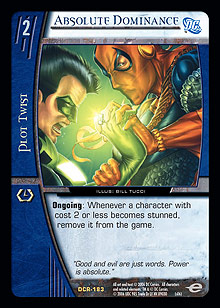
Last but certainly not least, we have the newest members of a revamped series of off-curve control cards. One of my pet creations from Golden Age was a deck called XMK Anarchy. The deck was a combination of X-Men and Marvel Knights and was my personal answer to the off-curve decks that were running rampant through the metagame. With four copies of both
Mikado and Mosha and
Flame Trap, it often severely brutalized the off-curve decks that I played against. Of course, no card could quite match the cruelty of
Total Anarchy. With a nasty KO effect for all tiny characters,
Total Anarchy had a natural combo with
Luke Cage, Street Enforcer. Unfortunately,
Total Anarchy is not playable in Silver Age. But Upper Deck made a near doppelganger in
Absolute Dominance.
Absolute Dominance doesn’t affect as broad a spectrum of cards, limiting its board-clearing effect to characters with cost 2 or less. But the cards that
Absolute Dominance does affect get far more thoroughly abused than they ever did by
Total Anarchy. Instead of simply KO’ing characters, it removes them from the game. Gone are the days of using Dr. Light to bring back a Kyle Rayner or
Felix Faust to clutter the board with
Anti-Green Lanterns. The little guys have a new enemy, and this ongoing plot twist makes sure that when it gets rid of a weenie, that weenie stays gone!
Starter Decks
25)
Flying Kick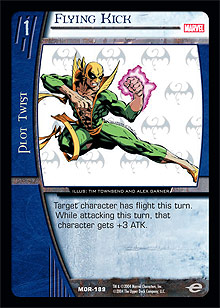
The final card on my list is, in my opinion, the paragon of Vs. System. It is not the most powerful ATK pump in the game, nor is it by any means broken, but
Flying Kick is the standard by which all other ATK pumps are judged . . . and quite possibly the perfect card.
Flying Kick provides a +3 ATK boost to a target character while it’s attacking and flight for the turn.
In any deck that attacks, we want each non-character card in our deck to provide as much benefit to our characters as possible. This is why Savage Beatdown is such a potent card. Despite being restricted to use only while a character is attacking and when you have four or more resources, the +5 ATK that it provides to an attacker is pretty much unmatched. I thought about the minimum bonus an ATK pump would have to provide for me to consider playing it in a deck and decided that I might play an ATK pump that provided +2 ATK. However, in order for me to consider such a card seriously, it would have to provide some additional outstanding benefit. In general, I try to limit myself to cards that provide +3 ATK or better. Flying Kick sits right on this threshold, but it is special in that it also allows for a little more versatility in play. Much like No Man Escapes the Manhunters and Glass Jaw, Flying Kick can be played at any time during the turn. And, of course, the additional benefit of flight is no small gift, as it allows characters that were grounded before to take to the skies and disrupt opponents’ formations. It may not be the biggest or baddest ATK pump, but Flying Kick may very well be the best one available in Silver Age (or any other age, for that matter)!
Whew! That was quite a lot to absorb! I hope that you enjoyed reading my not-so-little guide to the Silver Age metagame. Hopefully, it will even help one or two of you out there with some tough deckbuilding decisions.
I’ll be back after the PC next week for your standard Breaking Ground fare. In the meantime, you can always reach me at BigSpooky1@hotmail.com. If you are planning to attend the PC in San Francisco this weekend, be sure to hunt me down to say hi. I’ll be the big guy wearing the squirrel hat!
Take care and good luck to all in the upcoming Silver Age!
* Just ask Jayson Hartless! Jayson and Summer Bailey were playing against each other in a Marvel Knights Sealed Pack PCQ. On turn 6, Jayson dropped Summer to -3 and presumably to defeat. In the recovery phase, Summer flipped two copies of Meltdown to go back up to 1. The end result? Summer beat Jayson on turn 7! Don’t feel bad, Jayson . . . Summer beats me a lot, too!
** While No Man Escapes the Manhunters is not really an ATK pump, per se, the effect that it creates is, for all intents and purposes, an ATK pump. Whether the card increases an attacker’s ATK or decreases a defender’s DEF, the end result is the same. Hence, cards that serve to decrease the DEF of a defender are referred to as ATK pumps.